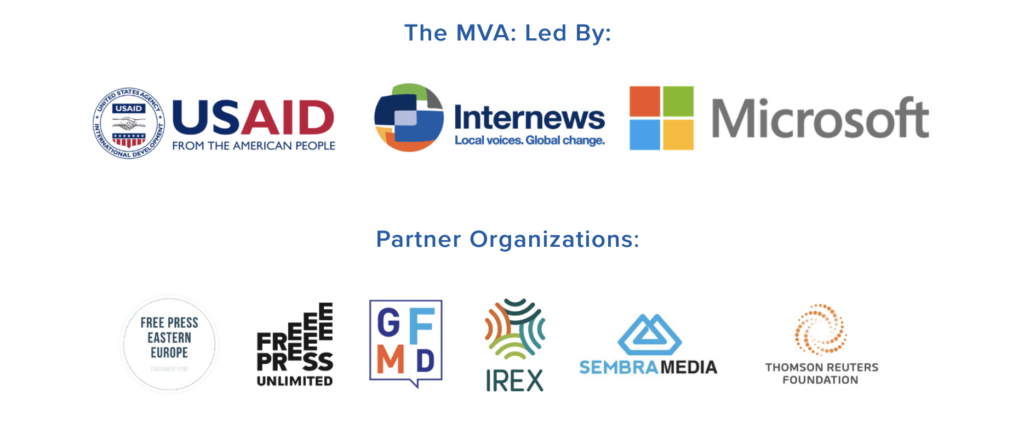About us
The MVA overview
Partnering with Microsoft’s Democracy Forward Initiative for leading-edge data aggregation and visualization tools, the MVA offers the kind of market intelligence that businesses need to be financially successful.


Meet MVA users
The MVA is for media outlets, funders, investors, technologists, consultants, accreditation bodies, media associations, researchers, academics and more. It provides insights free of charge.
Understand more about the MVA
The Media Viability Accelerator is a web-based platform to support independent media in becoming more financially sustainable.
The platform has two primary components. MVA Insights soft launched in May 2024. MVA Insights is a context-driven platform to track, benchmark and optimize media outlets’ business performance. MVA Solutions, launching later in 2024, will be a diverse marketplace of solutions and services aimed at media viability.
The creation of a platform such as the MVA has never been more essential. It is important that news and media outlets continue to hold power to account, on a national and local level and to do this, the sector must adapt and develop sustainable business models, to survive and thrive.
The MVA public-private partnerships model will create opportunities for learning and collaboration. USAID Administrator Power noted that “the U.S. government will use every tool … to support independent media, including by drawing on the expertise of our partners in the private sector”.
The MVA is far more than an analytical platform. It provides benchmarks and allows users to compare their performance with achievements of their peers. It connects users with organizations whose purpose is to help media outlets, and it allows experts who have media-focused solutions to offer them up to people who need them.
There are currently three types of organizations developing the MVA.
Funders: USAID created the MVA concept and is currently the initiative’s primary funder.
Technology Partners: Microsoft is the MVA technology partner. As requirements for the MVA became clearer in 2022, USAID and Internews approached Microsoft as an experienced and relevant technology partner, leading to an announcement of collaboration at the 2023 Summit for Democracy.
Microsoft’s Democracy Forward Initiative had already recognized the problem of shrinking independent media and the need to strengthen these entities to build strong democracies. Sitting within the Technology and Corporate Responsibility team, the Democracy Forward Initiative works to safeguard open and secure democratic processes, promote a healthy information ecosystem, and advance corporate civic responsibility. As part of protecting a healthy information ecosystem, Democracy Forward’s Journalism Initiative provides journalists and newsrooms with tools, technology, and capacity to expand their reach and efficiency. With its Azure cloud infrastructure, Power BI analytics and data visualizations, and Chat GPT technology, it brings the technological capabilities the MVA needs to become a successful solution that achieves widespread use and its own sustainable operation in the future.
Implementers: Following initial discussions with a media development ‘Consultation Group’ in March 2022, a smaller group of ‘MVA Partners’ have and continue with Internews to conduct research, test, and develop the platform. The MVA Implementation Partners are currently Free Press Unlimited, Global Forum for Media Development, IREX, SembraMedia and Thomson Reuters Foundation.
The initial Consultation Group additionally included Center for International Media Assistance, Deutsche Welle Academy, Fojo Institute, International Media Support, Media Development Investment Fund, Media Foundation for West Africa, News Consulting Group, and Splice Media.
The geographic scope of the MVA is global. MVA implementing partners are actively working to ensure broad geographical coverage. We are particularly focused on identifying media outlets and solution providers operating at the local level so that more localized approaches and technical expertise are available within the MVA over time.
Ensuring the MVA is available in multiple languages is a high priority. Currently the platform has ‘soft launched’ in English and will be in Spanish by the end of May 2024.
By full public launch, we are aiming for full system support in at least three languages, with parts of the system translated automatically into many more languages. We are working with MVA Partners to determine the rollout sequence of languages.
Based on the availability of funds and strategic priorities of the MVA, our aim is to offer subgrants to implementers working with media outlets using the MVA. Moreover, media outlets themselves that need support to integrate the MVA into their operations may receive targeted funding. Grants may also be made available to non-media organizations for the creation and implementation of additional MVA functionality.
The governance structure of the MVA will be led by a Steering Committee, consisting of the Funders (USAID and Microsoft), which provide strategic input, and the Lead Implementer (Internews) which manages MVA operations. This Committee is responsible for achieving the objectives of the MVA and makes day-to-day decisions about the MVA’s operations.
The MVA will also establish an informal Advisory Board for broader input from representatives of media outlets, media support groups, and academia. The Advisory Board will meet will provide feedback and advice to ensure the MVA is iterated and run with integrity, openness, and transparency; that it meets the principles of Diversity, Equity, Inclusion and Accountability (“DEIA”); that its work is innovative and useful in equitable measure to MVA stakeholders. Other governance structures are still being defined and organized, but the MVA will adhere to principles of broad engagement, consultation and transparency.
The MVA’s development is well-documented and the MVA team are currently rolling out guidance on how to effectively put it to use. This includes documentation describing how MVA Insights works and also (later on this year) how to integrate with MVA Solutions. Options for reaching a (human) support desk are also available.
The MVA is a global initiative. Its implementation is led by non-profit Internews, with headquarters in California, USA.
As the lead implementing organization of the MVA, Internews is responsible for ensuring the MVA’s compliance with relevant data protection principles and practices.
Internews and the MVA Partners are working towards a governance structure that ensures no organization will have preferred access to or insights from the sector’s use of the MVA when it goes live — including Internews. Until launch, anyone registering their interest in the MVA will become known to all MVA Partners, so we can avoid duplicating outreach efforts and so we can learn as much as possible about users’ needs as we progress with building the MVA.
Data will be stored in Microsoft Azure. The Azure customer data protection page states that “Microsoft does not inspect, approve, or monitor applications that customers deploy to Azure. Moreover, Microsoft does not know what kind of data customers choose to store in Azure. Microsoft does not claim data ownership over the customer information that’s entered into Azure.” This is an industry standard practice.
User data is managed in accordance with all data protection regulations and data residency requirements applicable in each of the countries where the MVA operates, such as GDPR for MVA users in the European Union.
MVA users choose who can access their data. These choices can range from allowing access by all logged-in users (e.g., an organization wanting to be found in the MVA Solutions marketplace), to only sharing data with specific people or organizations (e.g., sharing financial and capacity updates with media development organizations). Some data will be used for anonymized benchmarking (e.g., the average number of pageviews per visit on an investigative journalism website) but never in a way that reveals any individual media outlet’s identity or location. MVA users will always be in control of how their data is shared – or not shared.
Security of data within the MVA is a very high priority. The MVA has been built by organizations that are highly experienced in creating secure digital platforms; it relies on Microsoft’s proven technologies; its implementers have experience across all sectors of media, in most markets and environments, and understand the security needs of media organizations — including those operating amid extreme interference.
Personally Identifiable Information (“PII”) in the MVA is encrypted. Great care is being taken to enable the protection of PII related to media outlets and users operating in hostile environments. One of the primary aims of the MVA is to help independent media survive where they are under greatest threat.
The MVA does not benchmark media outlets on a per-country basis. Instead, it offers benchmarking according to characteristics of media outlets (e.g., hard news) and markets (e.g., low press freedom).
You will still be able to see your data in full, of course; and if you want to, you’ll be able to share any of it with partners you trust. But nobody will be able to trace your data back to you or your target country — unless you decide otherwise.
We know that some MVA uses will have intermittent and unstable access to the Internet, and that in general we want pages of the MVA to load quickly and efficiently. The MVA has therefore been designed with this in mind. It has also been developed to deliver alerts containing useful information and insights without users needing to log in. In addition to this, the MVA will comply with two US-based frameworks that help ensure wide accessibility: the Americans with Disabilities Act and Section 508 Guidelines.
In line with the USAID Policy Framework (2019), the MVA strives to Do No Harm (DNH). In practice, this means minimizing risk to users and integrating a proactive conflict sensitive approach in the design and implementation of this activity.
The MVA aims to promote a non-discriminatory, inclusive, and integrated development approach that ensures that all people, including those who face discrimination and thus may have limited access to a country’s benefits, legal protections, or social participation are fully included and can actively participate in and benefit from development processes and activities.
The MVA has been designed and continues to be further developed and updated, to support media by and for women and other communities who are subject to disproportionate levels of risk and underrepresentation.
The MVA platform is being launched gradually, with the predicted date for general admission being September 2024. Key dates are outlined below:
May 3: Admission for media outlets approved by an MVA Partner organization (see below).
September 2024: General admission.
